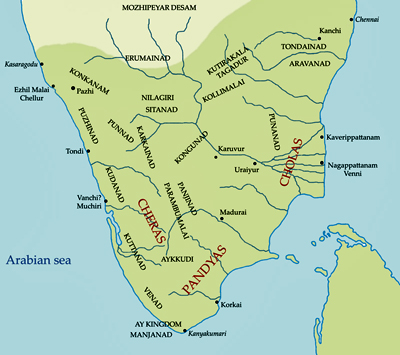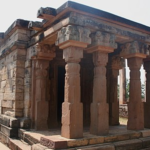Three Early Kingdoms
| Kingdom | Emblem | Capital | First Ruler | Famous Ruler |
| The Chera | Bow | Vanjji / Karayur; Main Ports : Muzris and Tondi | Udiyangeral | Senguttuvan (Red Chera) |
| The Chola | Tiger | Uraiaur-Inland capital-famous centre for cotton trade; Puhar/ Kaveripattanam-coastal capital-main port | Elara | Karikala |
| The Pandya | Fish | Madurai-Inland capital-venue of Ist and IIIrd sangam; Korkai/ Colchoi-coastal capital-famous for pearls | Mudukudumi | Nendujeliyan |
The Cheras
>> The Chera country occupied the portion of both Kerala and Tamil Nadu.
>> The capital of Cheras was Vanjji.
>> One of the earliest and better known among Chera rulers was Udiyangeral. It is said that he fed both the armies of Kurukshetra war and so earned the title Udiyangeral.
>> The greatest of Chera king, however, was Senguttuvan or Red Chera. It is said that he invaded the North and even crossed the Ganges.
>> He was also the founder of the famous Pattini cult related to worship of goddess of chastity-Kannagi.
The Cholas
>> The Chola kingdom called as Cholamandalam was situated to the North-East of Pandya kingdom between Pennar and Vellar rivers.
>> The Chola kingdom corresponded to the modern Tanjore and Tiruchchirap-palli districts.
>> Its inland capital was Uraiyaur, a place famous for cotton trade. One of the main sources of wealth for Cholas was trade in cotton cloth.
>> The earliest known Chola king was Elara who conquered Sri Lanka and ruled over it for nearly 50 years.
>> Their greatest king was Karikala (man with charred leg) who founded Puhar (Kaveripattanam) and constructed 160 km of embankment along the Kaveri river with the help of 12,000 Sri Lankan slaves.
>> They maintained an efficient navy.
>> The Cholas were wiped out in the attack of Pallavas from the North.
The Pandyas
>> The Pandyas were first mentioned by Megasthanese, who said their Kingdom was famous for pearls.
>> The Pandya territory included modern districts of Tirunelvelli, Ramand and Madurai in Tamil Nadu. It had its capital at Madurai, situated on the banks of Vaigai river.
>> The Pandya king profited from trade with Roman Empire and sent emissaries to Roman emperor Augustus and Trojan.
>> The earliest known Pandyan ruler was Mudukudumi.
>> The greatest Pandya king, Nendujelian, accused Kovalan of theft. As a result, the city of Madurai was laid under a curse by Kannagi (Kovalan’s wife).
Sangam Administration
> The king was the centre of administration. He was called Ko, Mannam, Vendan Korravan or Iraivan.
>> Avai was the court of the crowned monarch.
>> Important officials (Panchmahasabha): 1. Amaichchar (Ministers) 2. Purohitar (Priests) 3. Dutar (Envoys) 4. Senapatiyar (Commander) 5. Orar (Spies).
>> The kingdom was divided into Mandalam/ Nadu (Province), Ur (town), Perur (Big village), Sirur (Small village).
>> Pattinam (Name of coastal town), Puhar (Harbour areas), Cheri (Suburb of town).
>> Revenue Administration: Karai (Land Tax), Irai (Tribute paid by feudatories and booty collected in war), Ulgu (Custom duties), Iravu (Extra demand or forced gift), Variyam (A well known unit of territory yielding tax), Variyar (Tax collector).
Sangam Literature
>> Sangam was an assembly of Tamil poets held under royal patronage of Pandyan kings in Madurai.
>> The first Sangam was attended by Gods and legendary sages.
>> Of the second Sangam, the only surviving work is Tolkappiyam, an early work on Tamil grammar written by Tolakapiyyar.
>> Of the third Sangam, the mostly works are surviving. These are Ettutogai (i.e. 8 anthologies), Pattupattu (i.e. 10 idylls), Patinenkilakanakku (i.e. 18 didactical texts) etc.
>> Kural or Muppal, a part of Patinenkilakanakku and written by Tiruvalluvar is called ‘The Bible of Tamil Land’.
The Epics: Silappadikaram, Manimekalai, Sivaga Sindamani etc.
>> Silappadikaram (the story of the Anklet) : Written by Ilango Adigal, it deals with the story of Kovalan and Madhavi of Kaveripattinam. It is called ‘Illiyad of Tamil poetry.
>> Manimekalai: Written by Sittalai Sattanar, it deals with the adventures of Manimekalai, the daughter born of Kovalan and Madhavi. It is a sequel of Silappadikaram and strongly tinged with Buddhism.
>> Sivaga Sindamani livaka Chintamani): Written by Jain Tiruttakrdevas and strongly tinged with Jainism.
>> Bharatam: Written by Perudevanar.
Featured Image Courtesy: peppertrail



